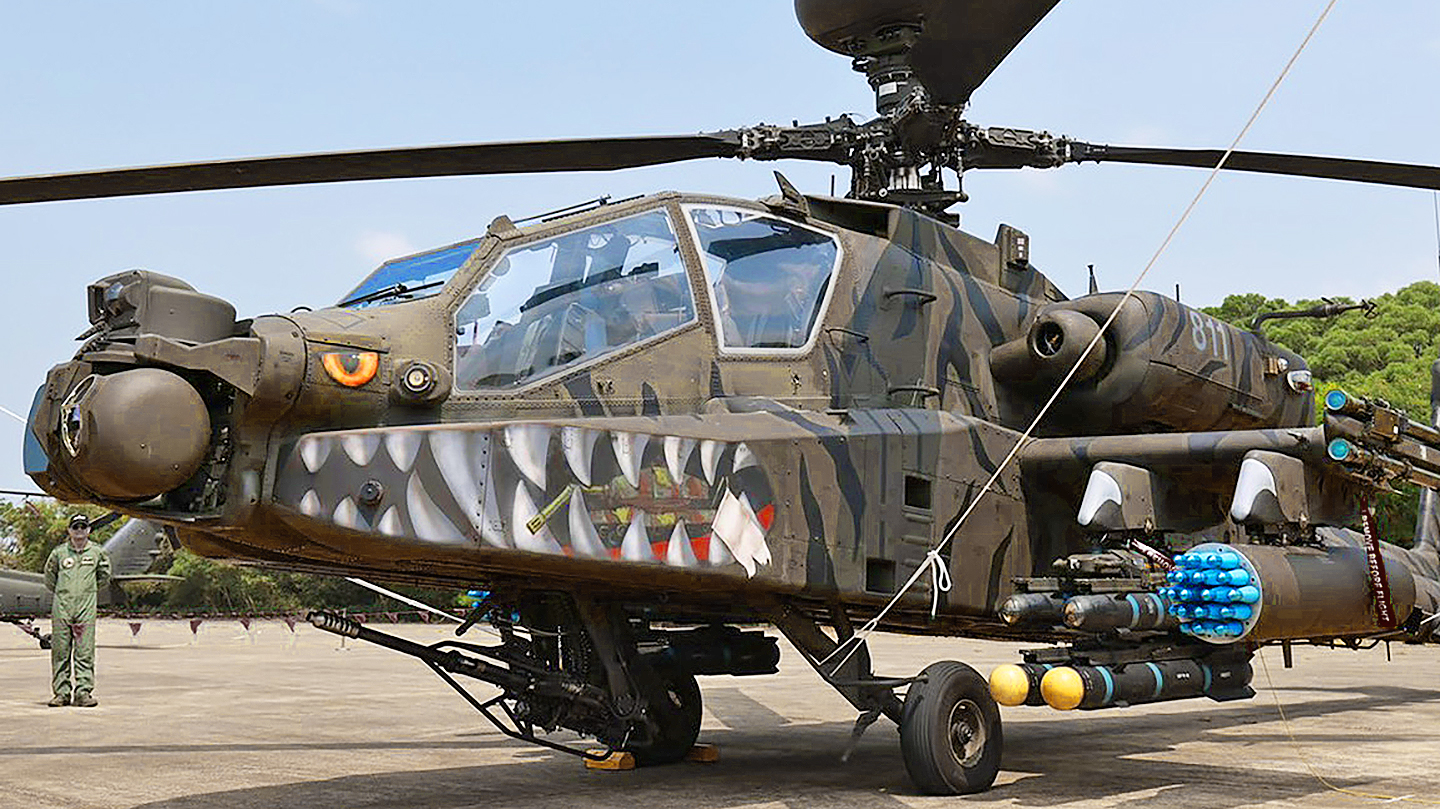The AH-64 Apache is indisputably one of the most evil-looking helicopters on the planet, with aesthetics that are befitting its role as a tank-busting, mud-moving battlefield killer. At least one operator of the attack helicopter even proudly uses the UGLY callsign. Taiwan, however, has recently gone the extra mile to make a portion of its Apache fleet look even more sinister.
Photos first published by the Taiwanese government outlet Youth Daily News show at least two Republic of China Army (ROCA) AH-64E Apache Guardians painted in this startling tiger-striped scheme with some incredible nose art.

Not only do the helicopters’ fuselages sport stripes over their standard olive drab exterior, but the forward fuselages feature monstrous teeth and glaring eyes. On one side, those teeth are chomping on a tank, forlornly waving a white flag of surrender.

The attention to detail extends to the ‘eyes,’ which are overlaid with targeting symbology — a nod to the information projected into the Apache crew’s iconic ‘monocles.’

At least one Taiwanese news report describes the teeth as representing a shark, suggesting this is loosely modelled on a tiger shark, but it’s irrelevant really, as the results speak for themselves.
It seems the two AH-64Es in question — serials 811 and 824 — and possibly more, were prepared with these special markings for an appearance at an open-doors event due to take place this Sunday, at the army airbase at Hsinshe (also sometimes written as Sinshe) on the west coast of Taiwan.
The event, billed as the National Defense Knowledge Tour, will include dynamic displays by fighters and helicopters, parachutists, disaster relief and search and rescue drills, air combat drills, and more.
One photo showing a pair of AH-64Es flying in close formation suggests that the tiger-striped helicopters are perhaps planned to perform a dynamic display together. If so, it’s not clear if this will be a new kind of regular display team or if it’s a one-off for this particular event.
The ROCA acquired 30 of the latest AH-64E versions of the Apache under a 2011 contract, reportedly valued at up to $1.91 billion. Deliveries began a year later and the fleet — reduced to 29 after a 2014 accident — became fully operational in 2018.
Taiwan’s AH-64Es are based at Longtan in northern Taiwan and provide the cutting edge of the ROCA’s aviation fleet. However, they remain far outnumbered by the older AH-1W Super Cobra attack helicopters, of which 62 are reported to be in service.

Outside of their airshow appearances, these ROCA AH-64Es have a critical wartime role, of course.
Should China ever invade Taiwan, which it views as a rogue province, there would be no shortage of targets for the AH-64Es on the ground, in the air, and at sea. To help them survive, they would be quickly dispersed to alternative operating locations — including parks and stadiums for operations in urban environments, for example.

Interestingly, while the AH-64Es are optimized for anti-armor missions, using their AN/APG-78 Longbow millimeter-wave radar and AGM-114L/M Hellfire missiles, Taiwan also assigns these helicopters an air-to-air role. This is highlighted in the images here that show the painted-up Apaches sporting AIM-92 Stinger air-to-air missiles in twin-mounted tubes located on the aircraft’s stub-wingtip stations. Hellfires can also be used in the counter-air role against slow-moving targets.

This has likely been driven not only by the potential threat of Chinese helicopters, hundreds of which are based just across the Taiwan Strait, including at a purpose-built heliport facility, but also by the proliferation of drones used by the People’s Liberation Army (PLA), and which have also proved a problem in peacetime, even leading to shootdowns.
As we have pointed out in the past, against the sheer might of the PLA, Taiwan’s wartime ambitions are understandably modest. Were an invasion to happen, the Taiwanese military would attempt to hold out unassisted for at least two weeks in the hope that the U.S. or the international community would come to its aid. This is a reflection not only of Taiwan’s own aims but of Washington’s policy of ‘strategic ambiguity,’ which means it hasn’t said it will necessarily commit its military to the defense of the island.


In the meantime, 2027 has been stated, including U.S. officials, by many as around the time China would be in a relatively good position to invade the island. According to CIA Director William Burns, Beijing would prefer peaceful unification of Taiwan, but its leadership has also told the PLA to be prepared no later than 2027 to conduct a successful invasion of Taiwan.
With all that in mind, the importance of the Republic of China Army’s AH-64E Apache Guardians cannot be overstated. While the menacingly painted attack helicopters are certainly eye-catching, their role in any potential confrontation with China would be deadly serious.
Contact the author: thomas@thedrive.com
